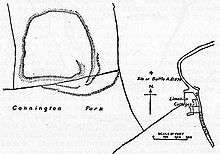Battle of Cynwit
The Battle of Cynwit, also spelt Cynuit, was a battle between West Saxons and Vikings in 878 at a fort which Asser calls Cynwit. The location of the battle is uncertain. Possible sites include Cannington Hill, near Cannington, Somerset;[1] and Countisbury Hill (also known as Wind Hill), near Countisbury, Devon.[2][3]
| Battle of Cynwit | |||||||
|---|---|---|---|---|---|---|---|
| Part of the Viking invasions of England | |||||||
| |||||||
| Belligerents | |||||||
| West Saxons | Vikings | ||||||
| Commanders and leaders | |||||||
| Odda, Ealdorman of Devon | Ubba † | ||||||
| Strength | |||||||
| Unknown | 1200 | ||||||
| Casualties and losses | |||||||
| Unknown | Unknown | ||||||
Prelude
A party of Vikings led by Ubba, son of Ragnar Lodbrok and brother of Ivar the Boneless and Halfdan Ragnarsson, landed on the coast at Combwich with 23 ships and twelve hundred men.[4] There they observed that a number of English Thanes and all of their men had taken refuge in the fort of "Cynwit" for safety.
Siege and battle
Ubba and the Vikings besieged the fort, expecting the English to surrender from lack of water.[4]
Aftermath

While the Anglo-Saxon Chronicle glosses over the battle of Cynwit, it is important for two reasons.
Firstly, it was an important victory for the English won by someone other than Alfred the Great, the king of Wessex at the time who was spearheading the English resistance to the Viking invasions. The Chronicle, in addressing the year 878, makes the claim that "all but Alfred the King" had been subdued by the Vikings.[5]
Secondly, at the battle of Cynwit, Odda, Ealdorman of Devon and the English forces not only succeeded in killing Ubba,[6] but they also captured the Hrefn, the Raven banner. While the Anglo-Saxon Chronicle only briefly mentions the battle, it does draw attention to the capture of the banner, which is interesting considering that it does not single out any other trophy captured by the English in the many other victories they had against the Danes.
The battle in fiction
The battle appears in The Marsh King, a children's historical novel by C. Walter Hodges, where its location is called "Kynwit". Although this novel is about King Alfred, it gives due credit to Ealdorman Odda for this victory, although the description of the battle may not be very accurate, showing the Vikings as making a landing at night and being defeated immediately on the landing ground.
The battle also features in Bernard Cornwell's novel The Last Kingdom. Cornwell ascribes the victory, as well as the killing of Ubba, to his fictional hero Uhtred, though he is supported by forces commanded by Odda.[7]
Notes
- Baggs & Siraut 1992, pp. 73-76.
- "Countisbury circular walk via Winston's Path". National Trust. Retrieved 20 April 2014.
- "MDE1236 - Countisbury Castle or Wind Hill Promontory Fort". Exmoor's Past. Exmoor National Park. Retrieved 20 April 2014.
- James 2013.
- Ingram 1912, Years 871-78.
- Kendrick 2004, p. 238.
- Cornwell 2005.
References
- Baggs, A P; Siraut, M C. (1992). "Cannington". In Dunning, R W; Elrington, C R (eds.). A History of the County of Somerset: Volume 6: Andersfield, Cannington, and North Petherton Hundreds (Bridgwater and neighbouring parishes). pp. 73–76.CS1 maint: ref=harv (link)
- Ingram, James, ed. (1912) [1823]. "Years 871-78". The Anglo-Saxon Chronicle. London: Everyman Press. Archived from the original on 2018-01-04. Retrieved 2012-03-21.CS1 maint: ref=harv (link)
- Cornwell, Bernard (2005). The Last Kingdom. London: Harper Collins.CS1 maint: ref=harv (link)
- James, Jeffrey (2013). An Onslaught of Spears: The Danish Conquest of England. The History Press. ISBN 9780750951982.CS1 maint: ref=harv (link)
- Kendrick, T.D. (2004). A History of the Vikings. Courier Corporation. ISBN 9780486433967.CS1 maint: ref=harv (link)
Further reading
- Keary, C. F (1891). The Vikings in Western Christendom. London: T. Fisher Unwin.
- Smyth, Alfred P (1995). King Alfred the Great. Oxford University Press.
- Early sources
- Asser. The Life of King Alfred.
- Æthelweard (1961). "Chronicon". In Campbell, Alistair (ed.). The Chronicle of Æthelweard. London.